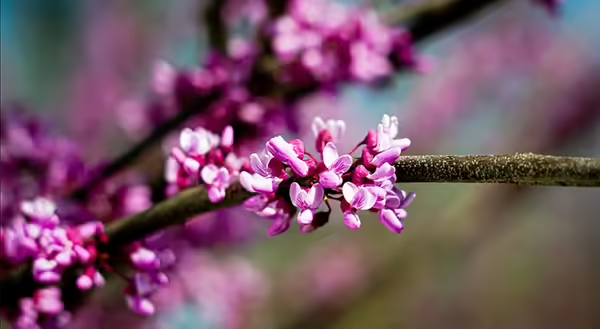
Signs of spring are beginning to pop up if you look close enough. In the last week or so, I’ve noticed harbinger of spring (Erigenia bulbosa) and spring beauties (Claytonia virginica) in natural areas. The beginnings of Virginia bluebells can also be found as their distinctly purple-blue new leaves poke up in more protected locations on the forest floor or in garden beds.
Daffodils (Narcissus spp.) and other non-native bulbs are up with flowers developing on plants in warmer microclimates. All the excitement at ground-level will build over the coming weeks as the full display of spring flowers emerge, and the landscape comes back to life.
With all this time spent gazing downward at blooms, it’s easy to overlook the more aerial floral display that so many of our early-flowering trees and shrubs can offer. They can help to provide an important vertical aspect in the landscape as larger specimens which frame the visual structure of plantings. When combined with spring ephemerals in a ground cover layer, they complete the planting and add a layering effect this is especially important to wildlife we hope to attract.
Flowering Favorites
It’s always hard to pick favorites, but this week I wanted to highlight a few of my personal “best picks” for spring flowering trees and shrubs. While there are certainly some beautiful wind-pollinated woody plants, such as red maple, that flower early. I’ve narrowed my discussion to insect-pollinated woodies that can support foraging pollinators in spring and boost the human-pleasing visual display in gardens.
Redbud (Cercis canadensis) is one of my all-time favorite trees. Its month-long flowering display graces my gardens for a good portion of April each year, providing both nectar and pollen to foraging insects. During other portions of the year, it is a host plant for larvae of one native butterfly and three native moths, providing support beyond bloom time.
As a smaller-sized tree, typically less then 30ft, it provides vertical structure without casting a large shade footprint. This allows for a thriving plant community of part sun plants under its smaller canopy. Pruning to increase light penetration can also aid in the support of underplantings.
Redbud works nicely as a specimen or in small groupings. While it tolerates shade, it performs better in full sun, which maximizes flower display. I just love this plant on the edge of patios or sitting areas, where artistic pruning, combined with its interesting, zigzagged twigs can create a lovely specimen that blends the hard edge of permanent structures into the living landscape.
Flowering dogwood (Cornus florida) is another small tree that is a spring-flowering powerhouse. It’s of similar size as redbud with the two species being the most prevalent native understory trees in Illinois woodlands and landscapes. Flowering times of both trees overlap, with dogwood blooming slightly later in spring.
The white to sometimes pink flowers of dogwood are dominated by colorful bracts (adapted leaves) as opposed to the petals that most observers assume to be present. Flowers offer both nectar and pollen and attract a wide range of pollinators. This plant has also been noted to support larval forms of native moths and butterflies. Some sources report over 120 native insects that are supported by dogwood at some point in their annual lifecycle.
Viburnums (Viburnum spp.) are a genus of native shrubs that flower in springtime offering an abundance of white to pinkish flowers at the tips of stems. They bloom a little later in spring than redbuds or dogwoods, with their flower display typically peaking in May when abundant white flowers cover these amazing shrubs and attract a wide array of pollination insects. They support many other native insects as hosts to larvae or food for twig and leaf-feeding insects. In addition, the fruits of many species are also attractive to birds.
These shrubs are larger in size, often reaching up to 20 ft tall, so plan for adequate space. Some favorite species of mine are nannyberry (V. lentago) or blackhaw (V. prunifolium) for locations with partial sun or shade, and arrowwood viburnum (V. dentatum) in full sun. Most species also provide great fall color as an added ornamental appeal.
A new favorite shrub on my list is black chokeberry (Aronia melanocarpa). I think this plant is highly underused in the landscape, and I’ve noticed it is becoming increasingly available at nurseries.
Abundant clusters of white flowers attract a variety of pollinators with both nectar and pollen. Foliage supports one native butterfly caterpillar and three native moth species’ larvae. The berries it produces later in the year are used by some birds as well.
This low-maintenance shrub thrives in full sun or partial shade, offering 3-4 weeks of blooms each May. In fall time it has a spectacular, red-purple foliar display. It is adaptable to a wide range of soil and site conditions. In addition, black chokeberry remains smaller in size, rarely exceeding 6 ft. tall at maturity, which allows it to fit into a wide range of landscape locations.